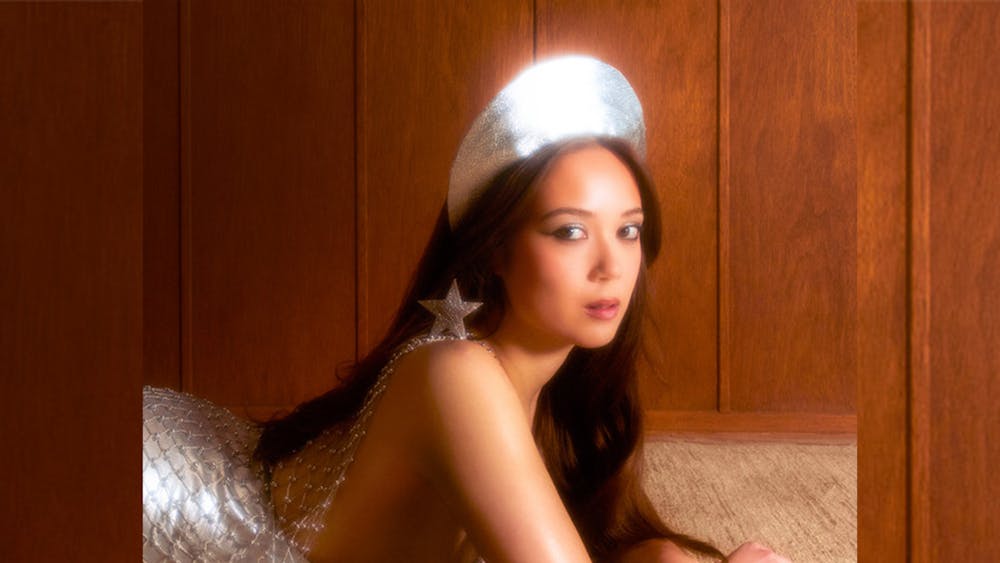IU Opera Theater's 2006 summer-season production of Arthur Gilbert and W.S. Sullivan's 1885 "The Mikado" is a breathtaking ball of operetta fun, wrapped in colorful threads of Japanese culture and bound by a thick yarn of tongue-and-cheek American laughter. \nMany audience members left the show last weekend feeling giddy, to say the least, as expressed in smiles glued to their faces and comments to one another like "that was great" and "I had a good time." My partner seated next to me, on the other hand, seemed bored out of her mind throughout the second half as she tapped her foot off-beat to the music and dozed off a few times in her seat, but I could not help join the rowdy standing ovation at the end of the performance to a job well-done.\n"The Mikado" chronicles the love affair of Nanki-Poo, the son of the Emperor -- or "Mikado" -- of Japan and played by IU graduate student Joshua Whitener, and Yum-Yum, played by IU graduate student Megan Radder. At the beginning of the show both Nanki-Poo and Yum-Yum are committed to marry others, but they fight Japanese custom and battle their lovers for the chance to spend the rest of their lives together.\nWhitener's acting and prancing overshadowed his voice, because his vocal chord projection often stopped short of reaching audience members sitting in the back of the Musical Arts Center. Radder's portrayal of Yum-Yum seemed on cue, and her musical and dance performance often blended well with the supporting cast of between 14 and 35 actors.\nNanki-Poo's destined lover before fate intervenes is the character Katisha, played by IU graduate student Jennifer Feinstein, and Yum-Yum is set to hitch Ko-Ko, Lord High Executioner, performed by IU graduate student Jacob Sentgeorge.\nFeinstein's acting is dramatic and necessarily overbearing, and her character's scorn compliments the playfulness of everyone else. Based on audience response throughout the show and during the curtain call, Sentgeorge stole the show, if not for the dynamics and dialogue of his character alone.\nHis acting and singing entertains the audience and his dancing highlights the other character's performances during their shared scenes.\nIU graduate student Alan Dunbar played Pish-Tush, IU graduate student Robert Brandt played Pooh-Bah and IU graduate student Gregory Brookes rounded out the main cast, more or less, as "The Mikado" of Japan. Although all cast members seemed to contribute their talents to an overall superb production, Brookes characterization of the multifaceted Pooh-Bah complemented Sentgeorge and he managed to make a place for himself on stage because of the dichotomy of the two characters together.\nBecause an operetta is wedged somewhere in between musical theater and dramatic opera, the performance blended sweet orchestral and vocal sounds with props used as rhythm and blues effects. While I do not pretend to have the slightest clue about what makes any opera successful, this production of the "The Mikado" blew my mind in terms of the theatrical possibilities of sound, color and prop usage.\nGuest conductor Raymond Harvey, music director of the Kalamazoo Symphony Orchestra, seemed to energize his instrument-wielding crew to blast musical missiles into the audience that pierced their hearts, blasted their minds and shocked their souls. Gilbert and Sullivan's notes kept a steady pace between giggles and darkness, and Harvey entertained the crowd with his waving arms and dipping knees.\nStage director Vincent J. Liotta's use of space was incredible, as magnified by the give and take of two to three characters center-stage and the stretching of the entire cast from one side of the stage to the other. His actors also seemed to hop, bounce and prance on and off-stage in between bouts of action, and his direction was most felt in the overall character movement throughout the show.\nMike Schwandt's lighting design also contributed to the overall quality of "The Mikado," especially through the use of deep blues, reds and oranges as a backdrop to offset character moods and the feel of the action on stage. Of particular notice, Schwandt's choice to front-light a few scenes projected the character's shadows onto the backdrop, which contributed to the overall spectacle but was not so overwhelming as to draw complete audience member attention.\nFor the sake of space, I am left with only a brief mention of the costumes and props, but I hope for your sake you will fill in the blanks with your imagination while watching the show this weekend. As a Japanese-themed operetta, audience members can expect the bright costume colors and extravagant wardrobe additions characterized in centuries-old Japanese portrayals. \nStill, the most exciting choice of costume décor was the interchange of dominant and decorative orange, yellow and white colors in Yum-Yum's costume that are flip flopped between the first and second act. Director of costume Parwin Farzad's use of colors was extreme considering no two costumes, out of the almost 40 presented, contained the same color or design patterns. \nLast but not least, the use of props as sound-creating machines was both creative and unique in terms of orchestra note additions and their use as cues to a character's feelings or overall mood. But do not take my word for it, after all, because I am a traditional-theater lover and "The Mikado" was one of the first tastes to the world of operetta I have ever experienced.\nI do not know if the IU Opera Theater's production added anything to the more than a century-old show, but I do know I left the Musical Arts Center feeling inspired by the local creativity and overwhelmed by the performance ability and combination of the actors involved. "The Mikado" may or may not strike your fancy, but I recommend you at least give it a shot this weekend. \nEven though the British-accented dialogue is somewhat hard to decipher early on in the show, most words are recognizable by the end and, either way, the mix of dialogue and orchestra sounds is enough to occupy the mind during about three hours of pure entertainment.\nThere is better way to spend a summer evening than laughing at the depiction of another culture, destined to attack America some 40 years later. \n"The Mikado" provides a meaningful bang-for-the-buck so to speak, and an once-in-a-lifetime experience I recommend for the entire Bloomington community.
Impressive lighting, dramatic performance highlight 'Mikado'
Get stories like this in your inbox
Subscribe





